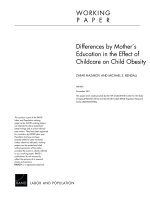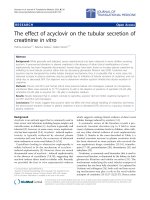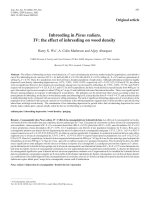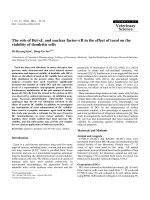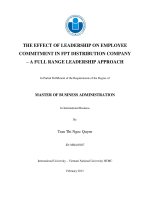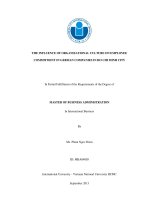The effect of leadership on employee commitment in FPT distribution company a full range leadership approach
Bạn đang xem bản rút gọn của tài liệu. Xem và tải ngay bản đầy đủ của tài liệu tại đây (1.54 MB, 119 trang )
THE EFFECT OF LEADERSHIP ON EMPLOYEE
COMMITMENT IN FPT DISTRIBUTION COMPANY
– A FULL RANGE LEADERSHIP APPROACH
In Partial Fulfillment of the Requirements of the Degree of
MASTER OF BUSINESS ADMINISTRATION
In International Business
By
Tran Thi Ngoc Quyen
ID: MBA03027
International University – Vietnam National University HCMC
February 2013
THE EFFECT OF LEADERSHIP ON EMPLOYEE COMMITMENT IN FPT
DISTRIBUTION COMPANY – A FULL RANGE LEADERSHIP APPROACH
In Partial Fulfillment of the Requirements of the Degree of
MASTER OF BUSINESS ADMINISTRATION
In International Business
by
Ms Tran Thi Ngoc Quyen
ID: MBA03027
International University - Vietnam National University HCMC
February 2013
Under the guidance and approval of the committee, and approved by all its members, this thesis
has been accepted in partial fulfillment of the requirements for the degree.
Approved:
----------------------------------------------
---------------------------------------------
Chairperson
Supervisor
----------------------------------------------
---------------------------------------------
Committee member
Committee member
i
ACKNOWLEGEMENT
This thesis is done with great deal of supporting from the wonderful people, who showed
significant concern towards me during the time of working on this dissertation. I would like to
take this opportunity to express my sincere gratitude to them.
I wish to express my deepest gratitude to Dr. Truong Thi Lan Anh for her great supervision
and continuous support as well as providing critical insights during the course of my research.
I would like to extend my thanks to all employees of FPT Distribution Company for their
time completing all questionnaires, especially for their assistance, coordination and support
during the research survey process.
Last but not least, I want to say thankful to my family, who always beside me and give me
power to complete my dissertation.
With many thanks,
ii
PLAGIARISM STATEMENTS
I would like to declare that, apart from the acknowledged references, this thesis either does
not use language, ideas, or other original material from anyone; or has not been previously
submitted to any other educational and research programs or institutions. I fully understand that
any writings in this thesis contradicted to the above statement will automatically lead to the
rejection from the MBA program at the International University – Vietnam National University
Ho Chi Minh City.
iii
COPYRIGHT STATEMENT
This copy of the thesis has been supplied on condition that anyone who consults it is
understood to recognize that its copyright rests with its author and that no quotation from the
thesis and no information derived from it may be published without the author‟s prior consent.
©Tran Thi Ngoc Quyen/MBA03027/2013
iv
Table of Contents
Chapter 1: INTRODUCTION......................................................................................................... 1
1.1.
Research background: .......................................................................................................... 1
1.2.
FPT Distribution Company introduction: ............................................................................ 2
1.3.
Rationales and Problem statement: ...................................................................................... 3
1.4.
Research objectives:............................................................................................................. 4
1.5.
Scope of research: ................................................................................................................ 4
1.6.
Significance of research: ...................................................................................................... 4
1.7.
Research structure: ............................................................................................................... 4
Chapter 2: LITERATURE REVIEW AND RESEARCH MODEL ............................................... 6
2.1.
Leadership: ........................................................................................................................... 6
2.1.1.
2.1.1.1.
Differences between Managers and Leaders:........................................................ 6
2.1.1.2.
Some definitions of leadership: ............................................................................. 7
2.1.2.
Traditional leadership theories: .................................................................................... 8
2.1.2.1.
Trait Theory: ......................................................................................................... 8
2.1.2.2.
Behavioural Theory: .............................................................................................. 9
2.1.2.3.
Contingency Theory: ........................................................................................... 11
2.1.3.
2.2.
Concepts: ...................................................................................................................... 6
Full-range leadership theories: ................................................................................... 14
Employee commitment: ..................................................................................................... 19
2.2.1.
Concepts: .................................................................................................................... 19
2.2.2.
Components of employee commitment: ..................................................................... 21
2.3.
Relationship between leadership and employee commitment: .......................................... 22
2.4.
Research model and hypothesis: ........................................................................................ 25
Chapter 3: METHODOLOGY ...................................................................................................... 26
3.1.
Research design: ................................................................................................................ 26
3.2.
Research process: ............................................................................................................... 29
3.3.
Population and Data sampling: .......................................................................................... 29
3.4.
Data collection: .................................................................................................................. 30
3.4.1.
Secondary data:........................................................................................................... 31
v
3.4.2.
Primary data:............................................................................................................... 31
3.4.2.1 Preliminary research: ................................................................................................ 32
3.4.2.2 Final survey:.............................................................................................................. 33
3.5.
Data analysis: ..................................................................................................................... 38
3.5.1.
Coding data: ................................................................................................................ 38
3.5.2.
Descriptive statistics: .................................................................................................. 39
3.5.3.
Reliability and Validity test: ....................................................................................... 40
3.5.4.
Regression analysis: ................................................................................................... 41
Chapter 4: RESEARCH RESULTS AND ANALYSIS ............................................................... 42
4.1.
Response rate: .................................................................................................................... 42
4.2.
Demographic data: ............................................................................................................. 42
4.3.
Results of Validity test: ...................................................................................................... 43
4.3.1.
Exploratory factor analysis –EFA of independent variables: ..................................... 43
4.3.2.
Exploratory factor analysis –EFA of dependent variables: ........................................ 44
4.3.3.
Rename factors: .......................................................................................................... 46
4.4.
Results of Reliability test: .................................................................................................. 49
4.4.1.
Cronbach‟s alpha for leadership variables: ................................................................ 49
4.4.1.1. Contingent Reward: ................................................................................................. 49
4.4.1.2. Personal Motivation: ................................................................................................ 49
4.4.1.3. Idealized Influence: .................................................................................................. 50
4.4.1.4. Management by exception: ...................................................................................... 50
4.4.1.5. Laissez-faire: ............................................................................................................ 51
4.4.1.6. Intellectual Stimulation: ........................................................................................... 51
4.4.2.
Cronbach‟s alpha for employee commitment variables: ............................................ 52
4.4.2.1. Continuance Commitment: ...................................................................................... 52
4.4.2.2. Affective Commitment: ........................................................................................... 52
4.4.2.3. Normative Commitment: ......................................................................................... 53
4.4.3.
4.5.
Restate Research Model: ............................................................................................ 53
Regression analysis and Hypothesis testing: ..................................................................... 56
4.5.1.
Correlation analysis: ................................................................................................... 56
4.5.2.
Regression analysis: ................................................................................................... 58
vi
4.5.3.
4.6.
Hypothesis testing: ..................................................................................................... 60
Differences among groups of followers:............................................................................ 63
4.6.1.
T-test: .......................................................................................................................... 63
4.6.2.
One-way ANOVA: ..................................................................................................... 64
Chapter 5: RESEARCH DISCUSSION AND IMPLICATIONS ................................................ 66
5.1.
Effect of personal motivation on continuance and affective commitment: ....................... 66
5.2.
Effect of idealized influence on continuance and affective commitment: ......................... 67
5.3.
Effect of contingent reward on continuance and affective commitment: .......................... 68
Chapter 6: RESEARCH CONCLUSION AND RECOMMENDATION .................................... 70
6.1.
Research Conclusion:......................................................................................................... 70
6.2.
Recommendation: .............................................................................................................. 70
6.2.1.
Personal motivation: ................................................................................................... 70
6.2.2.
Idealized influence:..................................................................................................... 71
6.2.3.
Contingent reward: ..................................................................................................... 72
6.3.
Limitation and suggestion: ................................................................................................. 72
REFERENCES ............................................................................................................................. 74
APPENDIX ................................................................................................................................... 82
Appendix 1: Structured interview ............................................................................................. 82
Appendix 2: Survey Questionnaire: .......................................................................................... 84
Appendix 3: Survey questionnaire (Vietnamese version) ........................................................ 87
Appendix 4: Descriptive Statistics ............................................................................................ 90
Appendix 5: Result of exploratory factor analysis ................................................................... 92
Appendix 6: Result of reliability test ...................................................................................... 100
vii
LIST OF TABLES
Table 1: Comparison between Leaders and Managers ................................................................... 6
Table 2: Studies of leadership traits and characteristic ................................................................... 9
Table 3: Summary of the development of Full Range Leadership Theory................................... 18
Table 4: Measurement for leadership variable.............................................................................. 35
Table 5 Measurement for employee commitment variable .......................................................... 37
Table 6: Summary of coding variables ......................................................................................... 39
Table 7: Summary of demographic data ....................................................................................... 42
Table 8: Rotated Component Matrix ............................................................................................ 43
Table 9: KMO and Bartlett's Test ................................................................................................. 44
Table 10: KMO and Bartlett's Test ............................................................................................... 44
Table 11: Total Variance Explained ............................................................................................. 45
Table 12: Rotated Component Matrix .......................................................................................... 46
Table 13: Summary of renaming factors after EFA...................................................................... 47
Table 14: Reliability coefficient of contingent reward measurement scale .................................. 49
Table 15: Reliability coefficient of personal motivation measurement scale ............................... 49
Table 16: Reliability coefficient of idealized influence measurement scale ................................ 50
Table 17: Reliability coefficient of management by exception measurement scale ..................... 50
Table 18: Reliability coefficient of laissez-faire measurement scale ........................................... 51
Table 19: Reliability coefficient of intellectual stimulation measurement scale .......................... 51
Table 20: Reliability coefficient of continuance commitment measurement scale ...................... 52
Table 21: Reliability coefficient of affective commitment measurement scale ........................... 52
Table 22: Reliability coefficient of normative commitment measurement scale ......................... 53
Table 23: Summary of revised research model............................................................................. 54
Table 24: Pearson's Rotated factor loading................................................................................... 57
Table 25: Regression – Coefficients of continuance commitment ............................................... 58
Table 26: Regression – Coefficients of affective commitment .................................................... 58
Table 27: Regression analysis at second round ............................................................................ 59
Table 28: Regression – coefficient of dependent variables .......................................................... 59
Table 29: Summary result of hypotheses test ............................................................................... 62
viii
Table 30: Group statistic on Gender ............................................................................................. 63
Table 31: Result of independent sample test ................................................................................ 64
Table 32: Test of Homogeneity of Variances ............................................................................... 64
Table 33: Result of ANOVA test .................................................................................................. 65
ix
LIST OF FIGURES
Figure 1: The basic leadership approaches ................................................................................... 14
Figure 2: A Model of the Full Range Leadership Development Theory ...................................... 16
Figure 3: Conceptual framework .................................................................................................. 25
Figure 4: Research process ........................................................................................................... 29
Figure 5: Restated Research Model .............................................................................................. 54
Figure 6: Resulted model .............................................................................................................. 63
x
ABSTRACT
This research investigates the relationship between leadership styles and different types of
employee commitment in FPT Distribution Company. The literature provided discusses the
leadership and employee commitment.
Information was gathered, using two instruments, from a sample of 210 raters. The
Multifactor Leadership Questionnaire, which was formulated from Bass and Avolio‟s (1997)
Full Range Leadership Development Theory, was used to determine leadership style within the
organisation. Employee commitment was captured using Meyer and Allen‟s (1997)
Organisational Commitment including Three-Component Model of employee commitment.
Leadership was identified as the independent variable and organisational commitment as the
dependent variable. Data obtained from each of the research instruments was then statistically
processed in data analysis in order to refine and operationalize the conceptual model and to
investigate the relative effects of the various factors. Result of data processing indicated that
there are three factors affect employees‟ continuance and affective commitment such as personal
motivation, idealized influence and contingent reward. In which personal motivation and
contingent reward is the key factor and idealized influence is an important factor have an impact
on employee commitment.
The analysis emphasizes the importance of increasing level of employee commitment to
the organization by increasing rewards, often reviewing salaries or building mutual trust between
leaders and subordinates.
Keywords: employee commitment, leadership
xi
xii
Chapter 1: INTRODUCTION
1.1. Research background:
The increase of organization‟s day by day changes is becoming a major component of
everyday organizational functioning. These changes require most companies to supply the best
and highest quality of products and services. Therefore, employee commitment is extremely
crucial in order to remain competitive of these pressures. It can be said that the success of an
enterprise depends on many determinants ranging from internal to external. Along with capital
and resources, workforce is also the company‟s greatest assets. People are becoming a source of
competitive advantage for most organizations (Ulrich, 2000). Ulrich (2002) has argued in his
work that the competitive edge of companies no longer lies in its products, but in its people.
People are seen to be the lifeblood of organizations and they represent the most valuable
resources of organizations. It is undeniable that no organization can perform at top levels unless
each employee is committed to the organization‟s objectives and works effectively. However,
recruiting the right employees is not as difficult as making them devoted for the organization. It
is obviously affected by so many different reasons. The objective of the organization is not only
to acquire workforce but also look for an efficient and effective labor force.
Leadership is essentially the core and spirit of organizations which helps to maximize
efficiency and to achieve organizational targeted goals. According to Bass & Avolio (1993),
leadership styles are behaviors or processes that leaders conduct or participate in that enable
extraordinary things to be done in or by the organization. Leaders set a direction for the rest, they
help subordinates recognize what lies ahead; and visualize which achievement that can be
obtained; they also encourage and inspire their staff to work to their utmost. Effective leadership
helps company get through peril times and make the business run smoothly and successfully. It is
sure that without leadership, organization will move slowly, stagnate, and lose its initial way and
subordinates will quickly degenerate into argument and conflict. Much of the literature about
organizations stresses decision-making and implies that if decision-making is timely, complete,
and correct, then things will go well. Yet a decision by itself changes nothing.
1
Hughes (2005) had proved that the success of any organization is dependent upon the collection
of individuals, including leaders and subordinates, and the amount of effort each individual puts
into it. Many previous researchers recognize that employee commitment (Meyer et al., 2004;
Allen & Myer, 1990) and leadership styles (Bass, 1997; Bass et al., 2003) are of major factors to
the organizational success or failure. If leaders ensure that employees will have an opportunity to
be appreciated and recognized for their individual attempt, they will be ready to make profit and
contribute to the company‟s success. Allen & Myer (1990) also suggest that the continued
interest is a result of the belief that if properly managed, employee commitment can lead to
benefits such as leadership effectiveness, improved employee performance, reduced turnover and
absenteeism.
1.2. FPT Distribution Company introduction:
FPT Distribution Company (FDC) is one of seven affiliate companies of FPT
Corporation, Vietnam‟s largest informatics organization. It was officially established on April
13th, 2003 whose headquarter was located in Ha Noi and other branches was in Ho Chi Minh
City, Da Nang and Can Tho Province. FDC is always proud to have the country‟s largest
distribution network, with agents nationwide, and enjoys an annual average growth rate of
approximately 32 percent.
FDC has been the leader in both information technology and telecommunication market in
Vietnam. Currently, FDC is valuable partners with more than 60 leading IT companies from
around the world namely IBM, Microsoft, HP, Nokia, Toshiba, Oracle, Samsung, Computer
Associates, Apple, Intel, Symantec, NEC, etc. It is highly appreciated by consumers as well as
partners simply because FDC brings customers the latest IT products together with various types
and perfect quality. With its existing strengths and customer-oriented principles, FDC commits
to continue bringing its customers the added value, maintaining trust and credibility with
partners, developing in domestic market and expanding to foreign countries.
In general, the amount of employees in FDC increased slightly, from 553 in 2008 to 571 in
2010 (3.9% in 3 years). However, compared to the number of people who quit job and were
hired, this amount was small. In 2008, 26 staff including managers and employees left their
2
position in FDC and this became an alarmed situation when this proportion grew significantly to
45 in 2010. Disloyal employees considerably affect the organizational process since newcomers
need at least 2 month probation to catch up with working progress. Also, FDC has some longterm projects in IT distribution which requires the in-charge staff should take care of vendors as
well as retailers from the beginning till the end. If a member stops his/her work at the middle of
the progress, the project and company‟s turnover will surely influenced. Therefore, in order to
maximize profit and decrease all cost of recruitment or canceling project, leaders in FDC
recognize to sustain their competent people by building a strong commitment basis among their
workforce. Commitment is complex and continuous, thus it requires employers or managers to
discover ways of enhancing the work life of their employees.
1.3. Rationales and Problem statement:
FDC has well recognized human capital as a competitive advantage. Thus, for FDC‟s
vision to become a reality, its leadership relies on employees to execute strategic objectives. The
employees‟ knowledge, experience, skills, expertise, the ability to collectively innovate and their
decision making processes is the key to the success of FDC.
As you know that, most of FDC‟s profit comes from IT projects with big retailers. And a
project will surely run well unless sales managers have good relationship as well as enough
experience in dealing prices. However, in recent years, FDC may face challenges of losing
competent and experienced employees. They tend to move to FDC‟s competitors such as Viettel,
Digiworld,… Obviously, turnover among these competent employees results in interruptions in
normal operations, loss of efficiency, increased replacement and recruitment cost, project delays,
increased customer dissatisfaction, and many other difficulties. Lack of employee commitment
threatens the survival of the organization because a loss of a competent employee is a loss of
competitive advantage for the organization. The loss of skillful employees in FDC mainly lies in
the way of leading the organization. Thus, the ability of FDC‟s leadership to retain competent
employees is critical to its success.
It is said that committed employees tend to generate high performance business outcomes
as measured by increased sales, improved productivity, profitability and enhanced employee
3
retention. Although obtaining experienced employees is hard, keeping them deep-seated in
organization is harder. Therefore, this study is considered important to determine the relationship
between full-range leadership styles (i.e. transformational, transactional and laissez-faire
leadership) and employee commitment (i.e. affective, normative and continuance) in FPT IT
Distribution Company – a subsidiary of FPT Corporation. And the purpose of this study is
figuring out which factors of leadership in the company can significantly influence employees in
FDC and how to improve these factors in order to increase the level of a staff‟s commitment to
an enterprise.
1.4. Research objectives:
This research is aimed to:
-
Identify which leadership attributes affect employee commitment of FDC.
-
Examine their importance towards employee commitment.
-
Suggest solutions to improve leadership for higher employee commitment to
organization.
1.5. Scope of research:
This research was done in FPT Distribution Company in Ho Chi Minh City, focusing on
follower perspective.
1.6. Significance of research:
This dissertation contributes to understanding of emerging leadership styles in FPT
Distribution Company and their impacts on commitment. It helps managers to understand the
importance of improving the way of leading in order to increase employees‟ long-term
commitment.
1.7. Research structure:
This thesis comprises 5 chapters as below:
4
-
Chapter 1: Introduction
This chapter gives a brief introduction about research background, problem should be solved of
the company and objectives of research.
-
Chapter 2: Literature review and research model
This chapter introduces conceptual framework about some related concepts and theories of the
study, then hypotheses are built based on these basic concepts.
-
Chapter 3: Methodology
This chapter states the method used in research which includes research design and instrument,
data collection and sampling and also the way how to analyze data in order to test the
measurement and conceptual framework.
-
Chapter 4: Research results and analysis
This chapter presents and discusses the results of the correlation analysis of the research
hypothesis and the assessment of the reliability of the research data.
-
Chapter 5: Research discussion and Implications
After presenting the results of the research in the previous chapter, the implications of these
results are now discussed in the light of the literature review.
-
Chapter 6: Research conclusion and Recommendations
Research limitations are identified and recommendations of the research are also discussed in
this chapter.
5
Chapter 2: LITERATURE REVIEW AND RESEARCH MODEL
2.1. Leadership:
2.1.1. Concepts:
2.1.1.1. Differences between Managers and Leaders:
Controversy has arisen over whether leaders are different from managers or they are the
same. Actually, both of them are essential for an organization‟s prosperity. While leaders
develop the vision, managers carry out the vision. Managers should therefore acknowledge the
importance of the leadership component of their work and be developed to become leaders who
achieve goals. Leadership is arguably based on purpose, change, and emotions, in contrast,
management is based on objectives, stability, and rationality. Below table defines some
differences between the two concepts:
Leaders
Managers
Are the heart of an organization
Are the brain of an organization
Motivate, encourage and work with people
Establish systems
Create a vision and set a direction, and share Create rules and operational procedures
with followers
Align people based on their knowledge, Are a task-oriented and often not peopleabilities and personality
oriented
Ask how and when
Ask what and why
Take you to a new place
Take care of where you are
Wonder that if the problem set in a new Think
environment might require a different solution
that
a
successful
solution
management problem can be used again
Write business plans, set budgets and monitor Get organizations and people to change
progress
Do things right
Do the right things
(Source: Colvard, 2009)
Table 1: Comparison between Leaders and Managers
6
to
a
2.1.1.2. Some definitions of leadership:
There are a number of definitions and views on the nature of leadership in the literature.
According to Sorenson (2002), Stogdill‟s Handbook of Leadership, first published in 1974, listed
4,725 studies of leadership and 189 pages of references. Therefore, it is complicated to find a
standard definition for leadership. Bass (1985b) also supported this idea by noting that finding
one specific definition of leadership is a very complex task as studies on this topic are varied and
there is no single generally accepted definition. In the literature, leadership has been identified as
an important subject in the field of organizational behavior. Generally speaking, leadership
involves influencing other individuals to act towards the achievement of a goal. Some definitions
describe leadership as an act of influence, some as a process and yet others have looked at a
person‟s trait qualities (Lussier and Achua, 2001).
Various authors regard leadership as the behaviour of an individual when directing the
activities of a group toward a shared goal. John Martin (2005) defined “leadership reflects the
ability of one person to direct and control the activities of others, albeit from a slightly different
perspective than that of management. It still reflects the process of influence and therefore the
exercise of power”. Lee and Chuang (2009) also explained that the excellent leader not only
inspires subordinate‟s potential to enhance efficiency but also meets their requirements in the
process of achieving organizational goals. Fry (2003) explained leadership as use of leading
strategy to offer inspiring motive and to enhance the staff‟s potential for growth and
development.
Some authors define leadership as a process whereby an individual influences a group of
individuals to achieve a common target. Vecchio (1997) describes leadership as a process
through which leaders influence the attitudes, behaviors and values of others towards
organizational goals. This was supported by Jacques and Clement (1994) who defined leadership
as a process in which one person sets the purpose or direction for others and gets them to move
along together with him/her in that direction with competence and commitment.
Other researches defined leadership as the process of moving a group (or groups) in the
same direction through mostly non-coercive means. This definition is consistent with some
researchers such as Bass (1990a) and Yammarino (1997). Bass has been in the forefront of
7
approaching leadership in terms of styles. He has described three well-known styles of
leadership: laissez-faire, transactional, and transformational leadership. Transformational leaders
encourage subordinates to adopt the organizational vision as their own, through inspiration, thus
adopting a long-term perspective and focus on future needs (Bass, 1990b). Transformational
leaders tend to have a holistic perspective of organizational factors. Transactional leaders, on the
other hand, identify and clarify job tasks for their subordinates and communicate how successful
execution of those tasks will lead to receipt of desirable job rewards (Bass, 1990b). According to
Avolio et al. (1991), a transactional leader determines and defines goals for their subordinates
and suggests how to execute tasks. They provide feedback and rewards on completed tasks.
These leaders motivate subordinates to achieve expected levels of performance by helping them
to recognise task responsibilities, identify goals and develop confidence about meeting desired
performance levels. They also make subordinates understand how their needs and the rewards
they desire are linked to goal achievement. Laissez-faire leaders abandon their responsibility,
leave their subordinates to work relatively on their own and avoid making decisions (Bass,
1990b).
2.1.2. Traditional leadership theories:
2.1.2.1. Trait Theory:
Early studies analysed leadership based on hereditary attributes and compared traits of
leaders with those of followers. Trait approach emphasizes attributes of leaders such as
personality, motives, values and skills. By identifying specific traits or characteristics of leaders,
one could distinguish a leader from a follower (Hughes, 2005, p.25)
Research concerning trait theory concentrated on the following factors: (a) physical factors
such as age, height, weight, physique, health and appearance; (b) ability factors such as fluency
of speech, tone of voice, academic performance, intelligence, judgment and decision, insight and
initiative; and (c) personality features such as integrity, emotional control, self-confidence and
popularity (Bass, 1990a). According to this theory, an individual must possess these traits or
characteristics in order to assume leadership.
8
Seeking to ascertain if trait theory accurately predicted leadership potential, Mann had
reviewed trait studies, and reported that the foundation of trait theory lacked validity. Hence,
Stogdill (1974) completed a second review of trait leadership research which identified factors
associated with energy, age, status, mobility, education and intelligence as being able to separate
effective leaders from ineffective leaders. However, Stogdill (1974) surmised that trait theory
research produced confusing results because a combination of traits proved effective in some
groups of leaders, while they were ineffective in others. Therefore, Stogdill concluded that
leadership requires more than just the study of people, but also the study of situations (Hughes,
2005, p26).
Stogdill (1948)
Mann (1959)
Stogdill (1974)
Lord et al.(1986)
Kirkpatrick and
Locke (1991)
Intelligence
Intelligence
Achievement
Intelligence
Drive
Alertness
Masculinity
Persistence
Masculinity
Motivation
Responsibility
Adjustment
Insight
Dominance
Integrity
Initiative
Dominance
Initiative
Confidence
Persistence
Extroversion
Self-confidence
Cognitive ability
Self-confidence
Conservatism
Responsibility
Task knowledge
Socialbility
Cooperativeness
Tolerance
Influence
Sociability
Table 2: Studies of leadership traits and characteristics (Northouse, 2001)
2.1.2.2. Behavioural Theory:
Failure of the trait theory led to further research that focused on behavioural styles of
leadership. Behavioural leadership proposed that behaviour of the leader impacted work and
follower effectiveness. This era of research focused on leadership behaviour as a mean of
identifying the best way to lead. Under this approach, many studies were carried out to support
this theory, majorly: McGregor‟s Theory X and Theory Y (1960), the Ohio State and University
9
of Michigan Models (in Hellriegel et al., 2004) and the Managerial Grid Model of Blake and
Mouton (1964).
McGregor‟s (1960) Theory X and Theory Y model proposed two distinct theories of
leadership behaviours: one negative labelled theory X and the other positive labeled theory Y.
His theories contend that leadership behaviours are based on an assumption about employees.
His Theory X assumption includes the belief that employees dislike work and will avoid it if
possible. According to McGregor (1960), here managerial behaviours include coercing
employees, controlling their tasks and activities, and directing their behaviours. McGregor‟s
(1960) Theory Y assumption includes the belief that employees can view work as a positive
experience given the right conditions. Here, managerial behaviours include providing
encouragement, positive reinforcement and rewards.
The Ohio State studies were viewed as influential because the research focused on
activities of leaders, instead of traits (Bryman, 1986). Through this research, the Leadership
Behaviour Description Questionnaire was developed. Results of the Ohio State studies indicated
two major dimensions of leadership behaviour, labelled “consideration” and “initiating
structure”. Consideration reflects the extent to which the leader establishes trust, mutual respect
and rapport with the group. This dimension is associated with two-way communication,
participation and the human relations approach to leadership. Initiating structure reflects the
extent to which the leader defines and consolidates group interactions toward attainment of
formal goals and organizes group activities. This dimension is associated with efforts to achieve
organizational goals.
Leadership research during the 1940s conducted at the University of Michigan compared
the behaviour of effective leaders with ineffective leaders. These studies resulted in the
development of two type of leadership behaviour (Bryman, 1986). Employee-centered leaders
focus on the individual needs of followers, while job-centered leaders direct activities toward
efficiency by focusing on reaching task goals and facilitating the structure of tasks. Although the
employee-centred and job-centred styles of leadership correspond to the Ohio State studies
concepts of consideration and initiating structure, the Michigan studies concluded that leaders
used one type of leadership and did not change styles depending on employee competency.
10
One popularized outgrowth of the emphasis on leader behaviour aimed at both task and
people issues is the Managerial Grid, developed by Robert Blake and Jane Mouton (Blake &
Mouton, 1985, p.10-11). The foundation of the theory is the contrast between two approaches to
the managerial role: (a) concern for production and (b) concern for people (Bryman, 1986).
Blake and Mouton believed that both concerns are essential ingredients of effective management
and each is conceptualized as a nine-point scale, thus producing eighty-one possible
combinations of managerial behaviour. They later added flexibility as a third variable. According
to Blake et al. (1964), leaders can only exhibit behaviours that fall into two primary categories
(task-oriented or people-oriented). Depending on which category is most frequently shown, a
leader could be placed along each of the two categories.
The behavioural approach looks at what effective and ineffective leaders actually do; how
they delegate tasks to subordinates, where and when they communicate to others and how they
perform their roles. Behavioural models made a great contribution to the understandings of
leadership, as the focus shifted from who leaders are (traits) to what leaders do (behaviours).
However, leadership behaviours that are appropriate in one situation aren‟t necessarily
appropriate in another. Because the behavioural models failed to uncover a leadership style that
were consistently appropriate to all situations, other leadership models were devised (Hellriegel,
et al., 2004).
2.1.2.3. Contingency Theory:
Contingency theories tried to predict which types of leadership style will be most effective
in different types of situations. Contingency approaches hypothesize that there are no universally
acceptable styles of leadership. A particular leadership style may prove valid in one situation, yet
ineffective in another. Many studies have attempted to isolate critical situational factors that
affect leadership effectiveness including the degree of structure in the task being performed, the
quality of leader-member relations, the leader‟s position power, subordinate‟s role clarity, group
norms, information availability, subordinate acceptance of leaders‟ decisions, and subordinate
maturity (Howell et al., 1986, p.88-102)
The models of contingency theory discussed include Leadership Continuum of
Tannenbaum and Schidt, Fiedler‟s Contingency Model, House and Mitchell‟s path-goal theory,
11
Hersey and Blanchard‟s Situational Leadership theory and Vroom and Yetton‟s Contingency
Model.
Fiedler‟s (1967) contingency theory posited that effective group performance was
dependent upon the appropriate match of the leader‟s personality and the situation. Personality
orientation of the leader is centered on a task or interpersonal style. Hellriegel and colleagues
(2004) indicated that leadership depends on matching a leader‟s style to a situation‟s demand.
Situational factors that influence leader effectiveness included leader-member relations, degree
of task structure, and power position of the leader. Leader-member relations referred to the
quality of the relationship between the leader and member (Fiedler, 1967). The leader‟s influence
over the members was enhanced through a strong relationship.
The path-goal theory of leadership (House, 1971) postulated that the eventual performance
and satisfaction of group members was highly influenced by the appropriateness of leader
behaviours in relation to member‟s needs and desires as well as the characteristics of the task.
Therefore, the function of the leader was to provide coaching, guidance and personal support to
members if necessary. The path-goal theory proposed that group members preferred a highly
structured regime when presented with ambiguous, varied and interdependent tasks. Initiating
structure and close supervision from the leader helped clarify the path-goal relationship and
increased the coordination, satisfaction and performance of the group members.
Hersey and Blanchard‟s (1977) situational leadership theory proposed that leaders should
vary their behaviours according to the member‟s maturity and they classified leader behaviours
along two dimensions: directive behaviour (similar to initiating structure and production-centred)
and supportive behaviour (similar to consideration structure and employee-centred). Directive
behaviour, described one-way directional communication from the leader to the member.
Supportive behaviour, described bidirectional communication from the leader when providing
social-emotional support for the member. Hersey and Blanchard (1977) also claimed that the
levels of directive and supportive leader behaviour should be based on the level of readiness of
the followers. Member maturity or readiness referred to the ability and willingness of members
to take responsibility for directing their own behaviour in relation to a specific task. These
behaviours are labeled as delegating, participating, selling, and telling.
12
